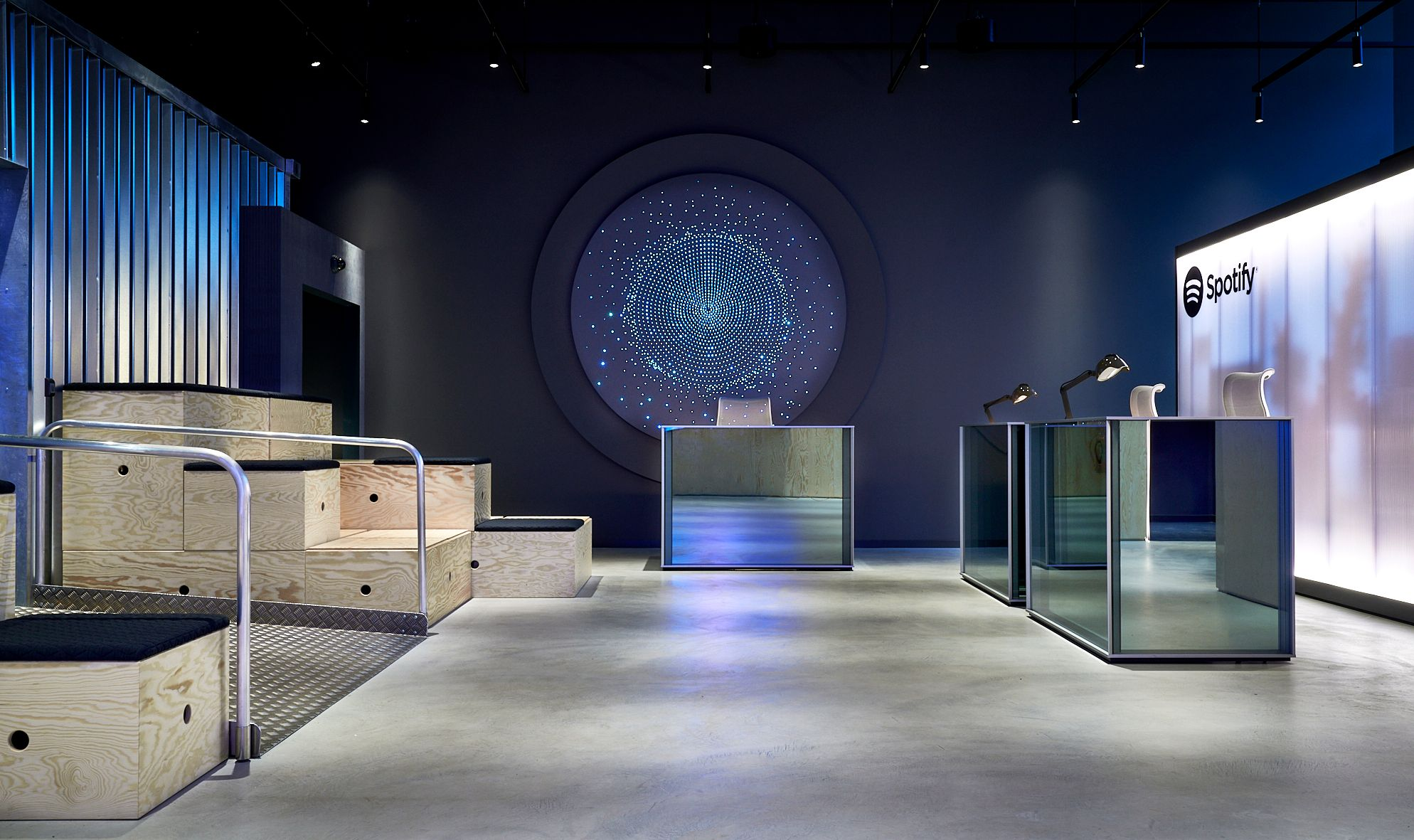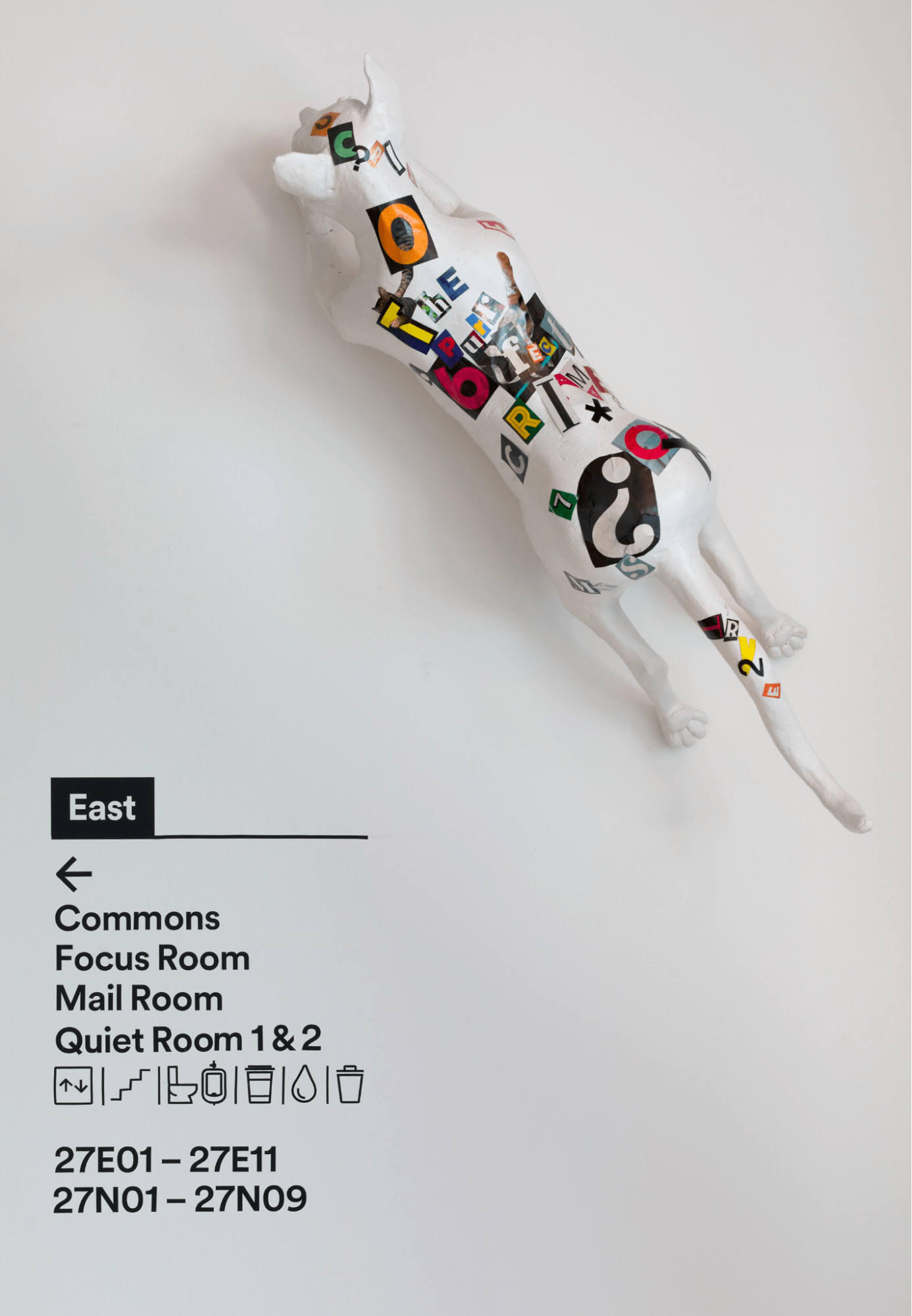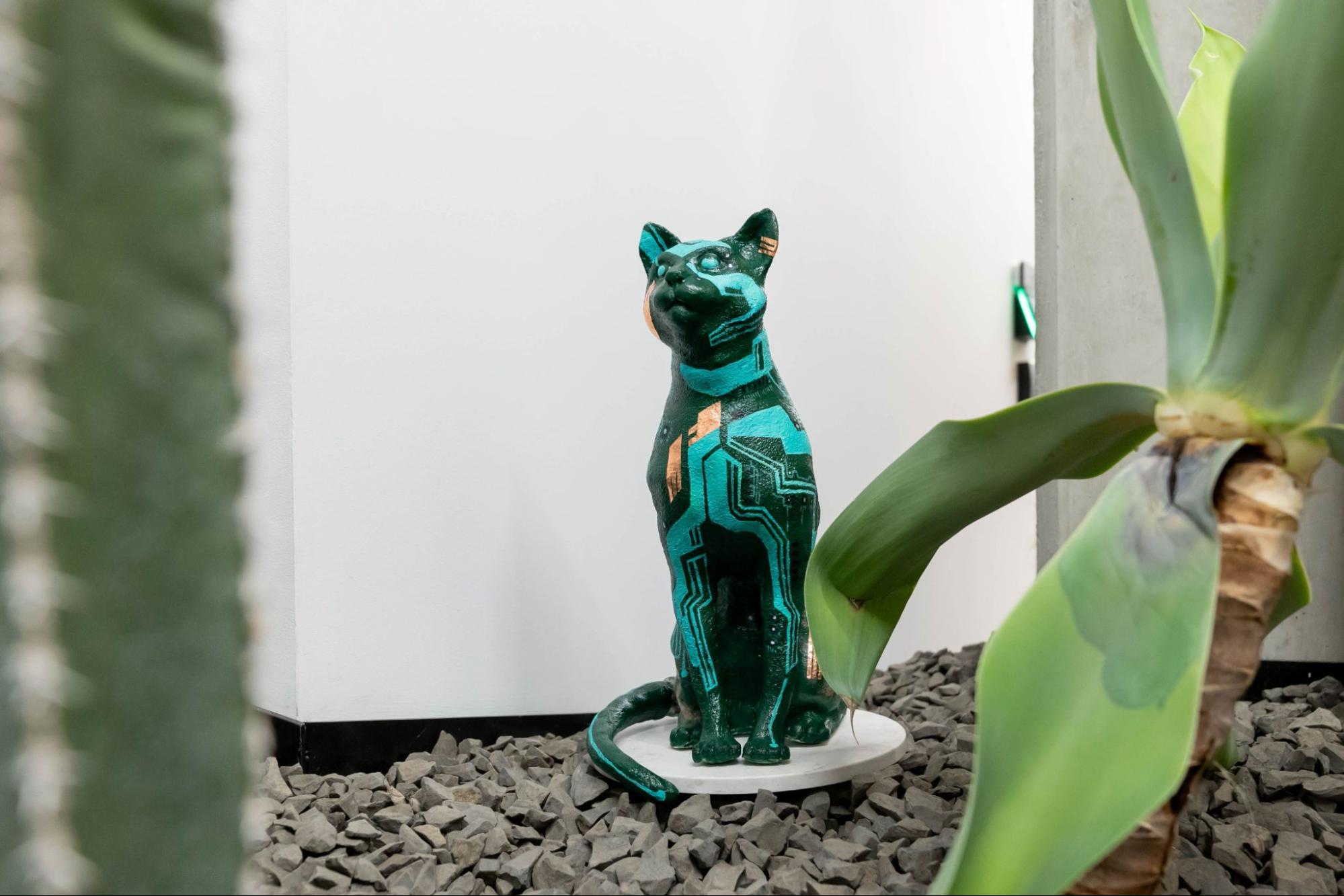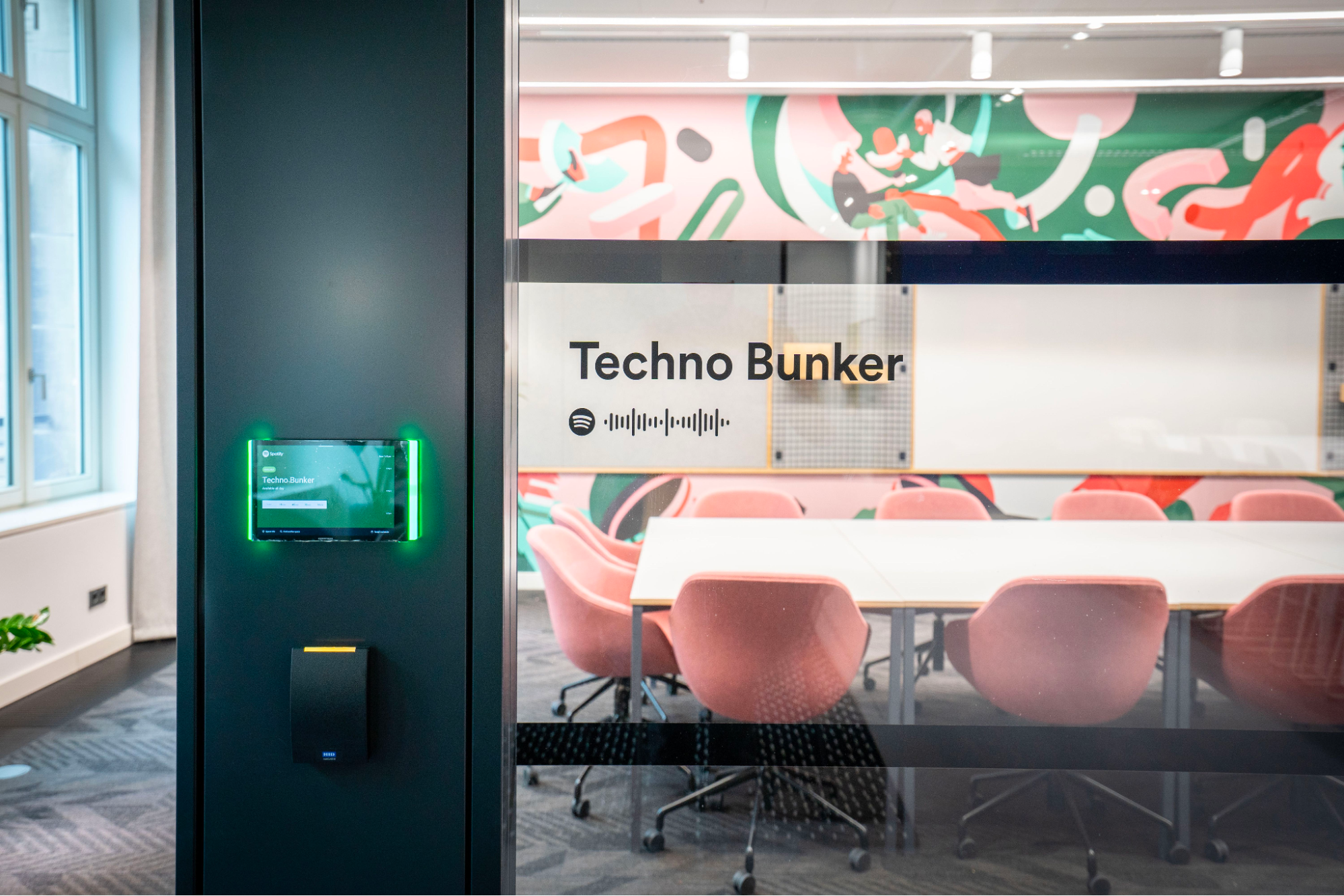Stepping into Spotify’s office in Los Angeles’s Arts District feels a bit like walking into an art gallery. Completed earlier this year, the space is filled with brightly colored murals and interactive art displays that light up and sound off as people pass by.
As part of a company-wide redesign project led by UK-based art and design collective Acrylicize, Spotify added these new visual elements to its offices across the globe, defining a new internal visual brand that emphasizes playful, dynamic spaces for employees, artists, and visitors to engage with audio in interactive ways.
Throughout 2021 and 2022, Spotify opened the doors to 19 offices from Toronto to Singapore to London. Nine of them were entirely new spaces to the company. Others, like its US headquarters in New York, were reimagined with new artwork, workspaces, and signage. In total, the project encompassed more than 1 million square feet of office space, with over 300 works of art, many of them created by local artists and curated by local teams.
The project came at the tail end of a two-year growth period that saw global employee headcount grow by 52%, from 3,813 people to 5,779, with new office spaces being added in rapid succession. It was a pace that left little time to determine a unified workplace-experience strategy. “We realized that we were in a period where we didn’t actually know what a Spotify office looked like,” says Sonya Simmonds, head of workplace innovation and design.
The Problem: Defining Spotify’s identity in a remote world
At the outset of the project in January 2020, Spotify prioritized crafting a global identity as a way to bring all their office space up to the same standard, while installing upgrades to boost engagement, retention, and talent acquisition. But as the ongoing pandemic sent Spotifiers home to work remotely, redesigning offices took on new importance as a way for the company’s distributed workforce to feel connected with the brand.
To that end, the Acrylicize and Spotify teams looked for ways to involve employees in the design process at each stage, through video updates and Blank Canvas, a company-wide magazine distributed physically and virtually. Long before the offices reopened for hybrid and in-person work, workers received an introduction to their new space.
“Now all of a sudden you don’t need to be in the physical space to share in the culture,“ explains James Burke, founder and global creative director of Acrylicize.
The Process: Global strategy meets local conversations
To bring its vision to life, Spotify turned to Acrylicize, which had previously created standalone projects for Spotify’s London and Stockholm offices. The collective had recently developed what it called the “Hyper Evolved Workplace” strategy, which prioritized building workspaces that balanced purpose and growth with community responsibilities to be equitable and sustainable.
“We really started talking about what the office needs to be through the Hyper Evolved Workplace strategy,” remembers Simmonds. “It let us look at our ways of working: our culture, our beliefs, and what Spotifiers want and need.”
They started with regular design workshops that met weekly to discuss how Spotifiers wanted to interact with their space. “One of the key insights from that experience was the phrase, ‘capturing the sawdust on the floor,” says Burke. “At Spotify, there was this real sense of making things happen on the ground.”
That focus on the company’s work helped the team land on a unifying principle for all their offices: a celebration of audio. They set out to design spaces that would bring Spotify’s podcasts, playlists, and artists to life throughout its offices, reminding employees of the company’s central purpose while highlighting each office’s unique location. Local Spotify teams were given the ability to select, critique, and shape creative direction, producing a unique feel from office to office that represents the community, podcasts, and artists related to each city.
The Result: A worldwide celebration of audio
Spotify fully opened its offices globally in May 2022, giving most of its employees a choice of hybrid, remote, or in-person working modes through its Work from Anywhere initiative.
The final spaces have some elements that have become the norm for modern workplaces, such as plenty of collaboration space and onsite dining and coffee shops. But the defining feature is the abundance of artwork that visualizes the music and podcasts that make Spotify unique.

Some of the pieces incorporate audio through speakers in the space, like New York City’s ‘Plant Performers (overleaf),’ in which transistors connected to houseplants allow plants to play music, and Stockholm’s Echo Spectrum, a circular LED light installation synchronized to live music inputs.

Other artwork celebrates audio silently. In New York, each of the 16 floors’ elevator bays bears a mural from a local artist. For three of the murals, Acrylicize and Spotify commissioned works by students at New York art programs, including Simiao Wang, who graduated from the School of Visual Arts with an MFA in 2021. Her mural, ‘Infinite Possibilities,’ depicts New Yorkers dancing, playing, and listening to music among colorful building blocks that evoke the city’s iconic architecture. “I wanted to show the freedom of the city and the infinite possibilities that allow us to do anything,” she says.

At the Los Angeles office, global HR lead Preeti Singh’s favorite artwork is a piece in the collection ‘Drumline,’ which depicts the opening drum break in Led Zeppelin’s ‘Moby Dick.’ For Singh, seeing artwork like ‘Drumline’ in meeting rooms and common spaces “keeps us centered by keeping things playful—we are an audio company, after all,” she explains.

Spotifiers across the globe can also spot painted ‘podcats,’ hiding among indoor plants or climbing up the walls. Originally inspired by a typo in an email between Acrylicize and Spotify team members that misspelled ‘podcasts,’ each of the cats is painted to represent a different podcast in Spotify’s catalog.


Meeting and communal spaces also pay homage to the playlists, albums, and podcasts that draw both creators and listeners to Spotify. Each meeting room bears a name with a corresponding Spotify listing, chosen by local teams in that office to represent their city or community. In Toronto, your meeting might be in The Weeknd, named after the Toronto native; in Berlin, Techno Bunker, named for a Spotify playlist spotlighting music visitors might find in one of the city’s many nightclubs.

Below the names are QR codes that, when scanned, pull up that playlist, podcast, or artist’s page in the Spotify app. For Simmonds, this interactive feature is illustrative of the way office design can engage employees who work there. “For Spotifiers,” she says, “it makes their work real within the space.”

“People are really engaged with the fact that it’s not just a kind of quiet room or a space to work,” she says.
Advice: To build an authentic global brand, engage your whole team
For Simmonds and Burke, establishing Spotify’s global brand has always been about engaging as many voices as possible, from the initial design workshops to working with local teams to choose the final artworks. “Get everyone involved as much as you can,” she says. “Ask people along because you’ll have a much richer project for it.” Acrylicize’s Burke chimes in, agreeing, “There’s insights in absolutely every corner of your organization.”
